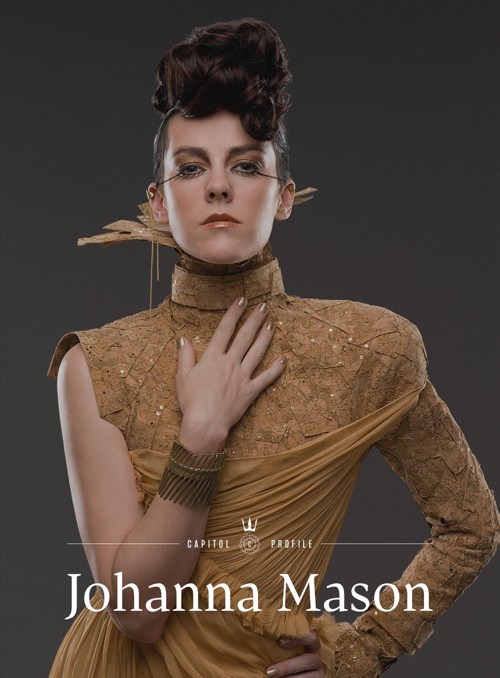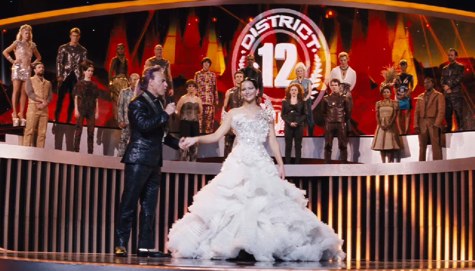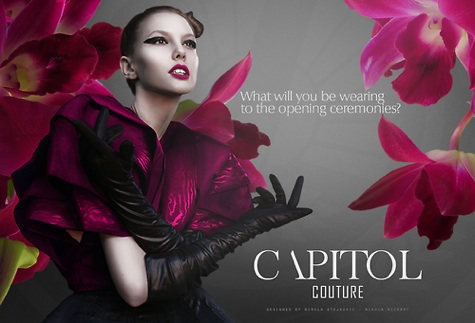It has been reported that as part of the viral marketing campaign surrounding the Hunger Games film sequel Catching Fire, a “luxury clothing line” called Capitol Couture will be released this fall. The line will feature 16 pieces from high-end designer Trish Summerville, all of them meant to reflect the outrageous fashion trends of Panem’s rich and privileged.
A luxury clothing line. I’m sorry, what is the Capitol meant to stand for in Suzanne Collins’ trilogy again? Hang on, it’s coming back to me…
Bear with me for some fashion talk. I promise, it’s pretty intriguing stuff.
So far the viral marketing for Catching Fire has been superb, even better than the work that went into the previous film’s campaign. There are websites devoted to couture spreads of each of the Quarter Quell champions, advertising them much in the way that you would expect the Capitol to—treating the former victors as assets in promotion, viewing them as canvases rather than people. It’s frighteningly real, which is why it’s jarring; if the Hunger Games were an activity that the world participated in, it wouldn’t be hard to imagine real ads and websites just like the ones being created for Catching Fire.
Asking actual fashion designers to contribute their visions to the project is inspired. It lends real credibility to the exercise, and it’s plain logical; you can’t ask a marketing department to design clothes and shoes, after all. What’s more, the designers asked to participate in these campaigns run the gamut—there have been world-famous contributors (Alexander McQueen and Dior have been heavily featured) and newer names who have something unique to bring to the party.

However, the Capitol Couture website is a test for those trying to find the line between reality and fiction. Within the profile article about Johanna Mason, actual designer Jan Taminiau gives this quote: “I love creating a fantasy around a woman’s body,” a reference to the tree-like garb he has her swathed in. Is this a true comment from the designer about the process of creating her look for the photoshoots and film, or something slipped in there by the author of the fake article to give the piece authenticity? Isn’t the point that we can’t really tell?
And that is exactly where the problem lies. With this much blurring between the world of the film and our own, I have to ask: How could anyone possibly feel good about shopping the Capitol Couture line? What are we saying if we buy these clothes—aren’t we buying into the very thing that Suzanne Collins’ books are trying to warn us against? It was bad enough last year with the Capitol-inspired nail polish line from the previous film’s release; at least wearing a specific color nail polish doesn’t do much by way of visually supporting the Capitol’s lifestyle. But wearing clothes with designs specifically derived from that society’s ethics and hollow glamor are inclined to make a different sort of visual impression.
Where fashion and fiction intersect is a fascinating subject; often fantasy worlds are populated with clothing that we subliminally recognize according to more recent history. While Star Wars characters are presumably wearing clothes from another galaxy, it is all too easy to look at Luke, Leia, and Han and say, “They look so 70s!” Because with their hair parted at the center and the v-necklines, there are plenty of cues that make it oh-so-clear when the film was made. Doctor Who is another great example of this trend; despite how oddball many of his costumes seem these days, the fashion choices of most Doctors are right in line with the years of their tenure.

Capitol Couture is meant to do something different—to be ahead of the curve, as outrageous as the overfed, over-stimulated, undereducated Capitol citizens are in the novels. And it’s intriguing that designers are partnering with the film as an excuse to push the envelope of what they can do, certainly. It’s also disturbing that this trilogy, which stands firmly against everything the Capitol creates and glorifies, is the inspiration behind such luxury items.
The chief marketing officer of Lionsgate was quoted saying that Capitol Couture “quickly became an out-of-world experience for both fans of the franchise and those obsessed with the future of fashion.” So let’s strip that comment down for examination: the suggestion is that the “future of fashion” might closely mirror what the Capitol hath wrought. That the bombastic consumerism and disregard for human life that they happily engage in is something that we should be fostering in the here and now by committing ourselves wholeheartedly to image over substance. It’s amazing when a creative work fosters so much more creativity in its wake, but there are times when some distance is dearly needed. That no one working to create these clothes is calling that out the irony of what they’re playing into makes the whole ploy more disturbing.
It’s just a harmless bit of fun, surely! we all want to say. Just because the books are doling out the opposite message doesn’t mean that the fans shouldn’t have their jewel-encrusted cake and eat all twelve tiers! I would love to agree with that, and in most cases I would. And no, we’re not sitting at home watching games that pit children against each other to the death, but here’s a question—where are these clothes being made, I wonder? Will they be lovingly sown by people of an appropriate age, who are making a decent living wage? Because clothing manufacture isn’t known to be the most humane business out there. And what about the cost of such “luxury items”? These are meant to be couture clothes. They will likely be expensive, much more than the teens and (mostly) lower-to-middle-class adults who adore the series can afford.
So in effect, this line of clothing is promoting the same disdain for those who have less—or none—that the Capitol citizens show for those occupying the numbered districts of Panem.

People who have zero interest in fashion may scoff at all of this regardless, but it doesn’t change the fact that clothes communicate. The Hunger Games Trilogy itself acknowledges this: Cinna’s designing of Katniss and Peeta are what make them a focal point in the Games, their costuming arguably one of the most important elements in keeping them alive. Fashion is used to exploit the tributes, and the slavish manner that Capitol citizens adhere to its trends show readers and viewers just how far removed they are from their own reality. It’s not surprising that clothing is an integral part of Collins’ world; what you wear tells people a story, it conveys how you want to be perceived, how you feel and what you think.
What are you communicating to the world if you decide to dress up like a denizen from the Capitol of Panem in your day-to-day life? Is being part of the “future of fashion” really worth associating yourself with those ideals?
The answer to that question, I hope, is an obvious one.
Emmet Asher-Perrin is only too happy to wear some laser-cut leather… but not if it means buying into Effie Trinket’s lifestyle. You can bug her on Twitter and read more of her work here and elsewhere.










